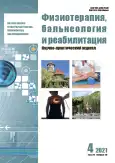Оценка эффективности комбинации некогерентного широкополосного света (IPL) и низких доз системного изотретиноина по сравнению с монотерапией стандартными дозами изотретиноина у пациентов с акне
- Авторы: Колодий А.А.1, Грязева Н.В.2, Круглова М.С.3
-
Учреждения:
- Клиника «Чайка»
- Центральная государственная медицинская академия Управления делами Президента Российской Федерации
- Первый Московский государственный медицинский университет имени И.М. Сеченова (Сеченовский Университет)
- Выпуск: Том 20, № 4 (2021)
- Страницы: 289-296
- Раздел: Оригинальные исследования
- URL: https://journals.rcsi.science/1681-3456/article/view/108253
- DOI: https://doi.org/10.17816/rjpbr108253
- ID: 108253
Цитировать
Аннотация
Обоснование. Длительный опыт клинического применения изотретиноина при акне свидетельствует о его хорошем профиле безопасности и эффективности, однако на фоне приёма стандартных доз препарата отмечаются выраженные нежелательные явления, которые носят дозозависимый характер. Именно поэтому поиск новых комбинированных схем лечения, позволяющих снизить дозу изотретиноина, является актуальной задачей.
Цель исследования ― оценить эффективность комбинации некогерентного широкополосного света (IPL) и низких доз системного изотретиноина (0,1–0,3 мг/кг массы тела в сутки) по сравнению с монотерапией стандартными дозами изотретиноина (0,5–1 мг/кг массы тела в сутки) у пациентов с акне.
Материал и методы. Дерматологический статус пациентов в ходе исследования оценивали с учётом дерматологического индекса GSS (Global Severity Sсore), дерматологического индекса акне (ДИА) и шкалы IGA (Investigator’s Global Assessment). Для сравнительного анализа влияния различных методик на качество жизни применяли высоковалидный индекс качества жизни. Дерматологический статус и качество жизни у пациентов оценивали до начала и по истечении 6 мес терапии. Спустя 12 мес пациентов приглашали в клинику с целью выявления отсроченных рецидивов.
Результаты. Оценивая в целом результаты лечения пациентов со средней степенью тяжести акне методом монотерапии изотретиноином и комбинированной терапии низкими дозами изотретиноина и широкополосным некогерентным светом, можно отметить эффективность обоих методов, однако клиническая ремиссия по данным глобальной шкалы тяжести (GSS) достоверно чаще наблюдалась в группе комбинированной терапии по сравнению с группой мототерапии (88 и 74% соответственно, p <0,05). Кроме того, в группе комбинированной терапии не выявлено рецидивов по прошествии 12 мес, а также реже наблюдались нежелательные явления, обусловленные применением изотретиноина.
Заключение. Таким образом, комбинированная терапия акне низкими дозами изотретиноина и широкополосным некогерентным светом является наиболее эффективной.
Полный текст
Открыть статью на сайте журналаОб авторах
Анастасия Андреевна Колодий
Клиника «Чайка»
Email: tynrik@yandex.ru
ORCID iD: 0000-0002-2944-0232
SPIN-код: 7644-0893
Россия, Москва
Наталья Владимировна Грязева
Центральная государственная медицинская академия Управления делами Президента Российской Федерации
Автор, ответственный за переписку.
Email: tynrik@yandex.ru
ORCID iD: 0000-0003-3437-5233
SPIN-код: 1309-4668
к.м.н., доцент
Россия, МоскваМария Сергеевна Круглова
Первый Московский государственный медицинский университет имени И.М. Сеченова (Сеченовский Университет)
Email: kruglovals@mail.ru
ORCID iD: 0000-0002-3190-7460
Россия, Москва
Список литературы
- Gold M.D., Baldwin H., Lin T. Management of comedonal acne vulgaris with fixed-combination topical therapy // J Cosmet Dermatol. 2018. Vol. 17, N 2. Р. 227–231. doi: 10.1111/jocd.12497
- Strauss J.S., Krowchuk D.P., Leyden J.J., et al. Guidelines of care for acne vulgaris management // J Am Acad Dermatol. 2007. Vol. 56, N 4. Р. 651–663. doi: 10.1016/j.jaad.2006.08.048
- Tan X., Al-Dabagh A., Davis S.A., et al. Medication adherence, healthcare costs and utilization associated with acne drugs in Medicaid enrollees with acne vulgaris // Am J Clin Dermatol. 2013. Vol. 14, N 3. Р. 243–251. doi: 10.1007/s40257-013-0016-x
- Pawin H., Beylot C., Chivot M., et al. Creation of a tool to assess adherence to treatments for acne // Dermatol. 2009. Vol. 218, N 1. Р. 26–32. doi: 10.1159/000165628
- Park C., Kim G., Patel I., et al. Improving adherence to acne treatment: the emerging role of application software // Clin Cosmet Investig Dermatol. 2014. Vol. 7. Р. 65–72. doi: 10.2147/CCID.S46051
- Dreno B., Thiboutot D., Gollnick H., et al. Global alliance to improve outcomes in acne: large-scale worldwide observational study of adherence with acne therapy // Int J Dermatol. 2010. Vol. 49, N 4. Р. 448–456. doi: 10.1111/j.1365-4632.2010.04416.x
- Jones-Caballero M., Pedrosa E., Penas P.F. Self-reported adherence to treatment and quality of life in mild to moderate acne // Dermatol. 2008. Vol. 217, N 4. Р. 309–314. doi: 10.1159/000151441
Дополнительные файлы











